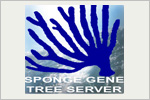Phylogeny & Systematics
Molecular phylogenetics and systematics aim at unravelling the relationships of organisms and the evolutionary processes that led to the observed patterns using molecular sequence data (DNA, amino acids). We are interested in questions at different levels of the tree of life, currently focusing our research on marine sponges, placozoans, and echinoderms.
The spatio-temporal levels of investigation range from recent ecological time and geographic structuring of genetic diversity of Indo-Pacific invertebrates to deeper branching in the animal tree of life, particularly within the major lineages of sponges (Phylum Porifera).
We are also deeply involved in DNA barcoding, a technique that uses short species-specific DNA fragments for rapid species identification. We pioneered DNA barcoding of sponges and currently coordinate the international Sponge Barcoding Project and curate the Sponge Gentree Server.
Key publications
- Erpenbeck, D., Galitz, A., Ekins, M., Cook, S. de C., van Soest, R.W.M., Hooper, J.N.A., Wörheide, G., 2020. Soft sponges with tricky tree: On the phylogeny of dictyoceratid sponges. Journal of Zoological Systematics and Evolutionary Research 58 (1): 27–40.
- Erpenbeck, D., Steiner, M., Schuster, A., Genner, M.J., Manconi, R., Pronzato, R., Ruthensteiner, B., van den Spiegel, D., van Soest, R.W.M., Wörheide, G., 2019. Minimalist barcodes for sponges: a case study classifying African freshwater Spongillida. Genome 62 (1): 1–10.
- Schuster, A., Vargas, S., Knapp, I.S., Pomponi, S.A., Toonen, R.J., Erpenbeck, D., Wörheide, G., 2018. Divergence times in demosponges (Porifera): first insights from new mitogenomes and the inclusion of fossils in a birth-death clock model. BMC Evolutionary Biology 18: 114.
- Galitz, A., Cook, S.D.C., Ekins, M., Hooper, J.N.A., Naumann, P.T., De Voogd, N.J., Abdul Wahab, M., Wörheide, G., Erpenbeck, D., 2018. Identification of an aquaculture poriferan “Pest with Potential” and its phylogenetic implications. PeerJ 6: e5586.
- Schuster, A., Cárdenas, P., Pisera, A., Pomponi, S.A., Kelly, M., Wörheide, G., Erpenbeck, D., 2018. Seven new deep-water Tetractinellida (Porifera: Demospongiae) from the Galápagos Islands – morphological descriptions and DNA barcodes. Zoological Journal of the Linnean Society 184, 273–303.
- Eitel, M., Francis, W.R., Varoqueaux, F., Daraspe, J., Osigus, H.-J., Krebs, S., Vargas, S., Blum, H., Williams, G.A., Schierwater, B., Wörheide, G., 2018. Comparative genomics and the nature of placozoan species. PLoS Biology 16, e2005359.
- Voigt, O., Ruthensteiner, B., Leiva, L., Fradusco, B., Wörheide, G., 2018. A new species of the calcareous sponge genus Leuclathrina (Calcarea: Calcinea: Clathrinida) from the Maldives. Zootaxa 4382 (1): 147.
- Haszprunar, G., Vogler, C., Wörheide, G., 2017. Persistent Gaps of Knowledge for Naming and Distinguishing Multiple Species of Crown-of-Thorns-Seastar in the Acanthaster planci Species Complex. Diversity 9 (2), 22.





